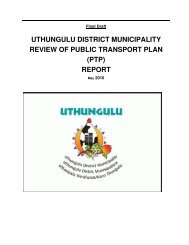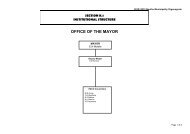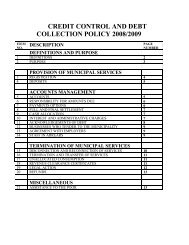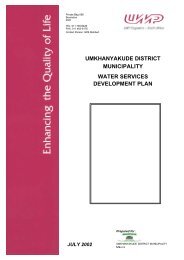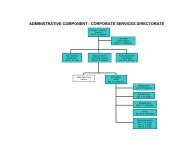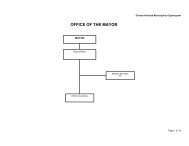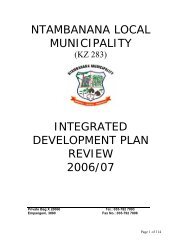Maphumulo IDP - KZN Development Planning
Maphumulo IDP - KZN Development Planning
Maphumulo IDP - KZN Development Planning
You also want an ePaper? Increase the reach of your titles
YUMPU automatically turns print PDFs into web optimized ePapers that Google loves.
environment, human skills, infrastructure and capital available to a specific area and how itcould contribute to increase its self-sufficiency.Principle of Spatial ConcentrationThe Principle of Spatial Concentration aims to build on existing concentrations of activitiesand infrastructure towards improved access of communities to social services and economicactivities. In practical terms this promotes concentration along nodes and corridors withmulti-sectoral investment i.e. roads, facilities, housing etc. Future settlement and economicdevelopment opportunities should be channelled into activity corridors and nodes that areadjacent to or link the main growth centres in order for them to become regional gateways.Principle of Sustainable Rural LivelihoodsThe Principle of Sustainable Rural Livelihoods considers rural areas in a way which isintegrated with other decision making associated with the Sustainable Livelihoodsframework. This principle requires that spatial planning consider the locality and impact ofhuman, physical, natural , financial and social capitals of an area and spatially structurethese in support of each other.Another aspect of this principle is promoting spatial planning in a continuum where ruralareas are not addressed as completely separate entities to urban centres, but rather agradual change in landscape with the potential progression of rural areas to more closelyresemble the service standards and quality of living achieved in some urban contexts.Principle of Balanced <strong>Development</strong>The Principle of Balance <strong>Development</strong> promotes the linking of areas of economicopportunity with areas in greatest need of economic, social and physical restructuring andregeneration at all spatial scales. In practical terms the principles sought to find a balancebetween the potentially competing land uses by understanding the relationship andintegration between major dimensions within the province and promoting a synergeticmixture of land uses in support of each other at various spatial scales.Principle of AccessibilityThe Principle of Accessibility simply promotes the highest level of accessibility to resources,services, opportunities and other communities. This is intrinsically linked to transportationplanning and should consider localised needs for the transportation of people and goods byvarious modes of transport as guided by the scale and function of a region. At a provinciallevel there is a strong correlation between the most deprived areas and poor regionalaccessibility to those areas. In addressing accessibility at provincial and local level, the needfor possible new linkages, the upgrade in the capacity of existing linkages and the suitablemix of modes of transport should be considered.Principle of Co-ordinated ImplementationThe Principle of Co-ordinated Implementation actually projects beyond spatial planning andpromotes the alignment of role player mandates and resources with integrated spatialplanning across sectors and localities. Essentially the principle suggests that planningimplementationbecomes a more continuous process and that government spending onfixed investment should be focused on planned key interventions localities. This principleultimately also proposes a move towards more developmental mandate definitions of thevarious departments away, from single mandates to enable the spatial alignment of growthand development investment.From these principles, the Provincial Spatial <strong>Development</strong> Strategy identified a number ofprovincial priority nodes, corridors and broad planning categories. The map overleafillustrates the resulting provincial spatial strategy, localised for the <strong>Maphumulo</strong> Municipalityand need to be read in conjunction with the tables below, providing a brief explanation tothe categories illustrated on the map.__________________________________________________________________________________________<strong>Maphumulo</strong> Integrated <strong>Development</strong> Plan (<strong>IDP</strong>) 2012 - 2013Final June 2012Page 74 of 142




